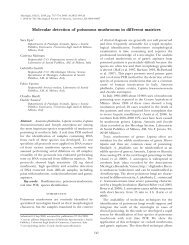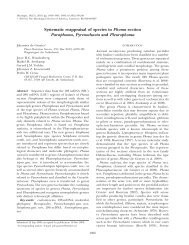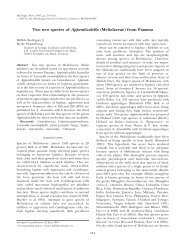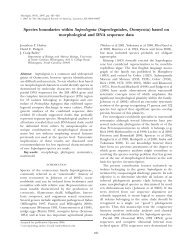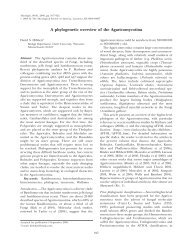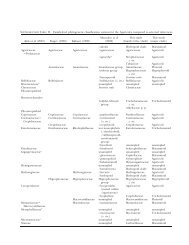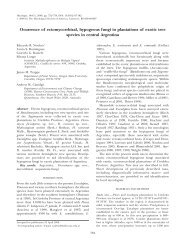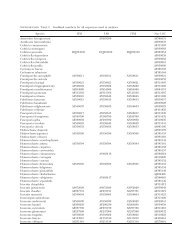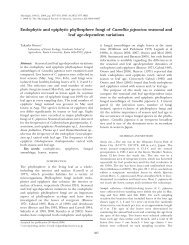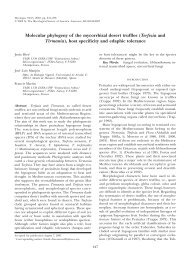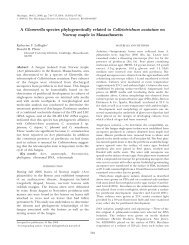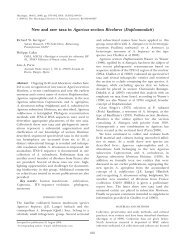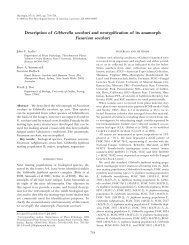Short title: Revision of Morchella taxonomy Taxonomic ... - Mycologia
Short title: Revision of Morchella taxonomy Taxonomic ... - Mycologia
Short title: Revision of Morchella taxonomy Taxonomic ... - Mycologia
Create successful ePaper yourself
Turn your PDF publications into a flip-book with our unique Google optimized e-Paper software.
attachment . . . . 4<br />
3. Associated with Populus trichocarpa in western North American river bottoms . . . . M. populiphila<br />
3′. Associated with various hardwoods from the Great Plains eastward . . . . M. punctipes<br />
4. Appearing in conifer burn sites; in western North America . . . . 5<br />
4′. Not found in conifer burn sites; variously distributed . . . . 7<br />
5. Surfaces densely tomentose (especially when young), covered with projecting hairs (120–250 + μm) that are<br />
brown in 2% KOH; hymenophore and stipe usually dark gray to black but sometimes becoming pale in direct<br />
sunlight . . . . M. tomentosa<br />
5′. Surfaces glabrous to finely tomentose, not covered with projecting hairs . . . . 6<br />
6. Elements on sterile ridges primarily capitate (<strong>of</strong>ten strikingly so) . . . . M. capitata<br />
6′. Elements on sterile ridges variously shaped, only occasionally subcapitate; following two species<br />
indistinguishable both morphologically and ecologically based on current data . . . . M. sextelata, M. septimelata<br />
7. Pits and ridges usually arranged in a "laddered" vertical appearance (FIG. 15); appearing in landscaping areas<br />
and woodchip beds in urban areas in western North America . . . . 8<br />
7′. Pits and ridges not usually arranged in a “laddered” vertical appearance . . . . 9<br />
8. Ridges velvety when young; known only from the 1935 type collection in Redmond, Washington . . . . M.<br />
hotsonii (see SUPPLEMENTARY MATERIALS)<br />
8′. Ridges glabrous or very finely tomentose. . . . M. importuna<br />
9. Found from the Rocky Mountains westward . . . . 10<br />
9′. Found from the Great Plains eastward . . . . 11<br />
10. Ridges pale yellowish when young, <strong>of</strong>ten darkening somewhat later; stipe strikingly ridged and lacunose . . . .<br />
M. snyderi<br />
10′. Ridges dark brown to black when young; stipe not strikingly ridged and lacunose …M. brunnea, and <strong>Morchella</strong><br />
sp. (= Mel-8)<br />
11. Distributed from roughly 44°N latitude northward (currently known only MI–NY); ascomata 40–75 mm high;<br />
ascospores (19–)20–22(–25) μm long . . . . M. septentrionalis<br />
11′. Widely distributed from the Great Plains eastward; ascomata 50–140 + mm high; ascospores 22–27 μm long . .<br />
. . M. angusticeps



